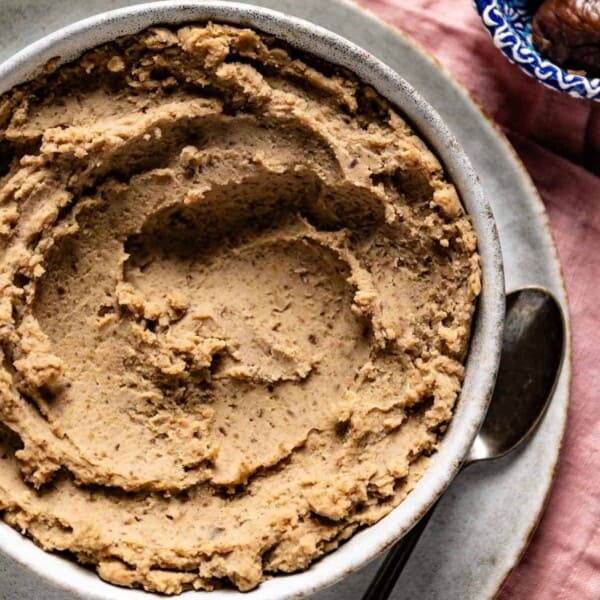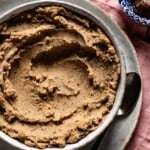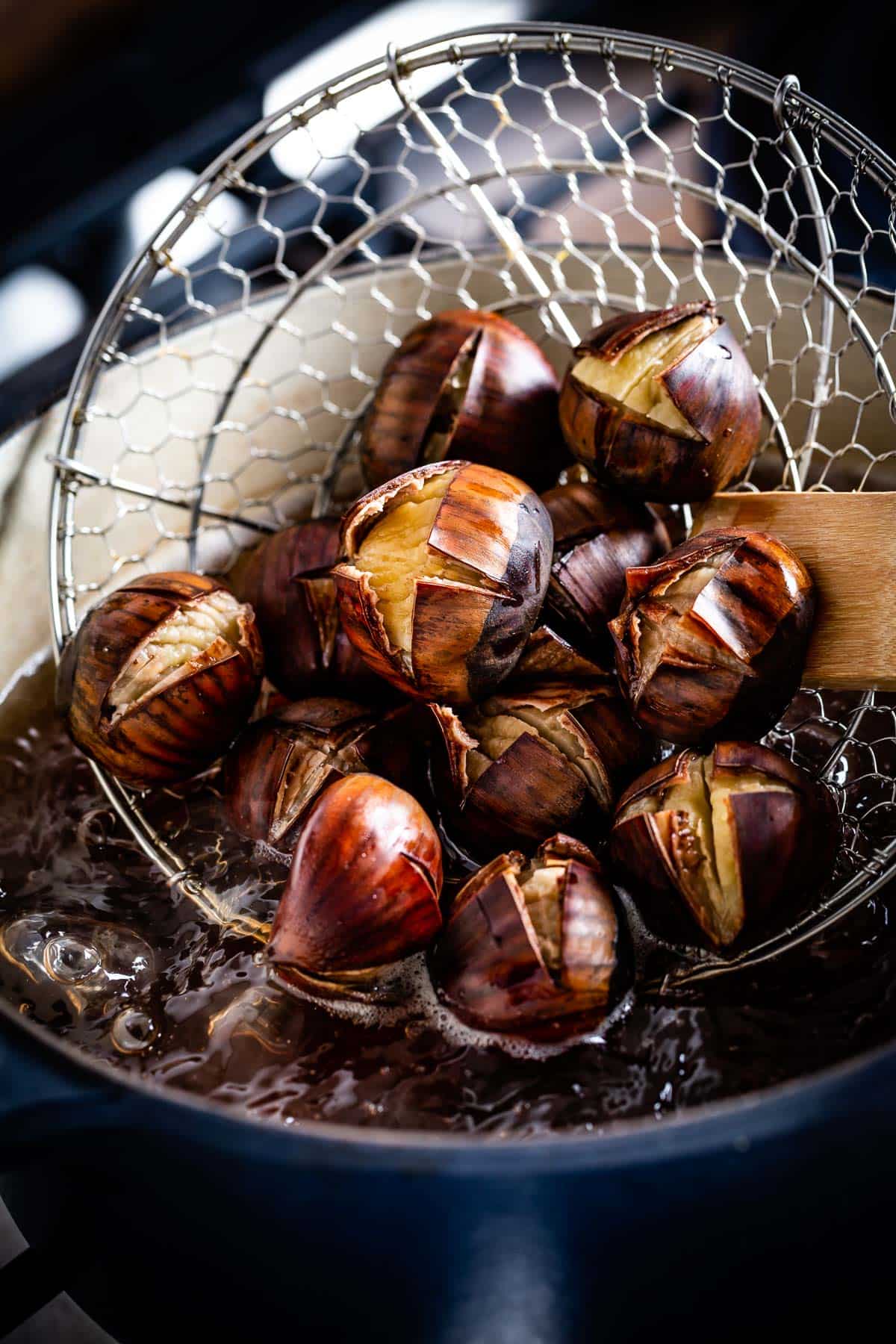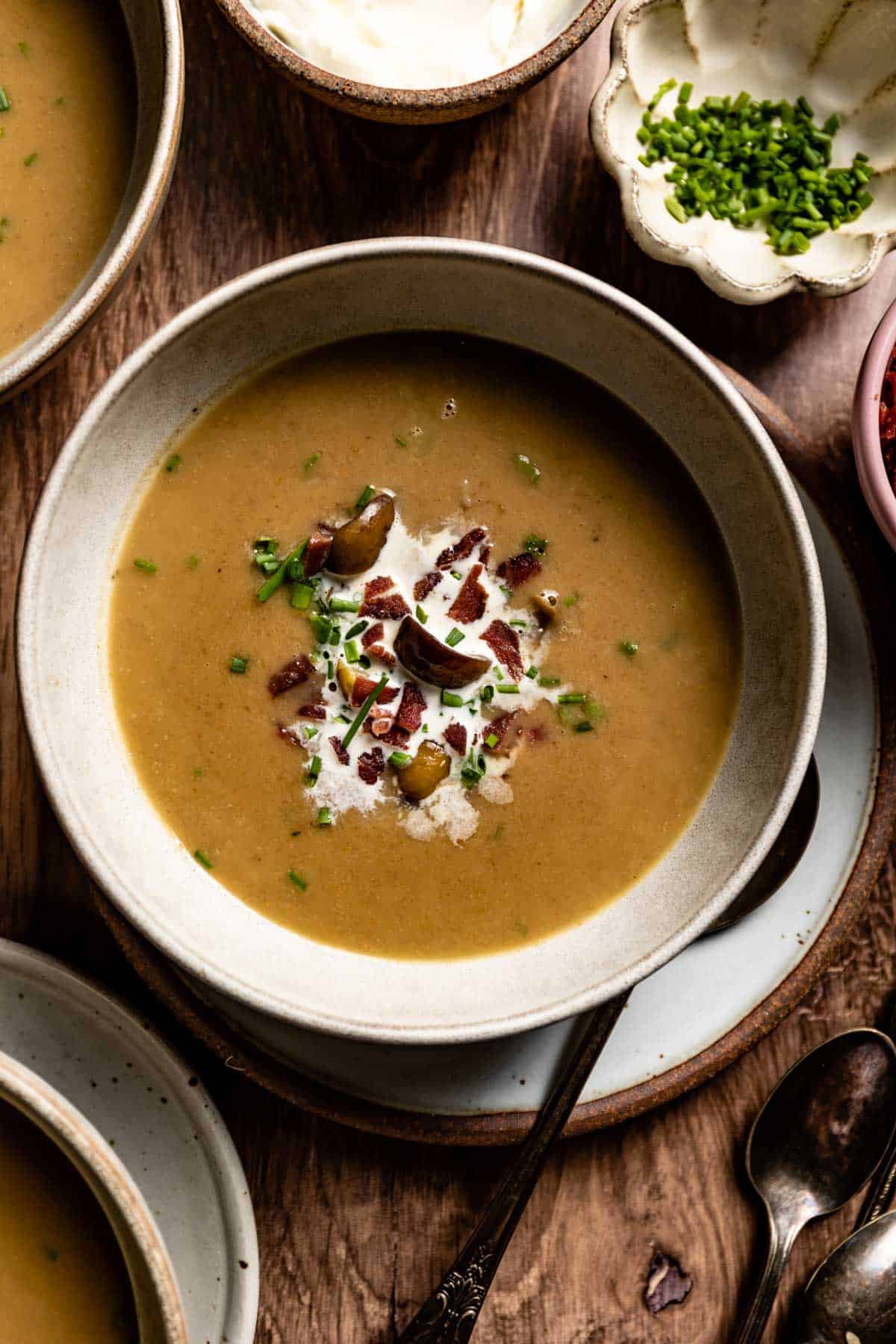Chestnut Puree vs. Chestnut Spread
Before we go into the details of making chestnut puree at home, allow me to explain the difference between chestnut puree and chestnut spread. Because even though they both include blending chestnuts to a creamy consistency, chestnut purée and chestnut spread aren’t the same thing.
Chestnut purée, also referred to as marron paste, tends to have a nuttier, earthier taste, as it comes together with a mixture of cooked chestnuts, milk (or water), a little (optional) sugar, and vanilla bean (or extract). Because of its mild, versatile flavor, chefs often use it in sweet and savory recipes. Furthermore, chestnut puree recipes usually remove most excess liquid, creating a more paste-like texture.
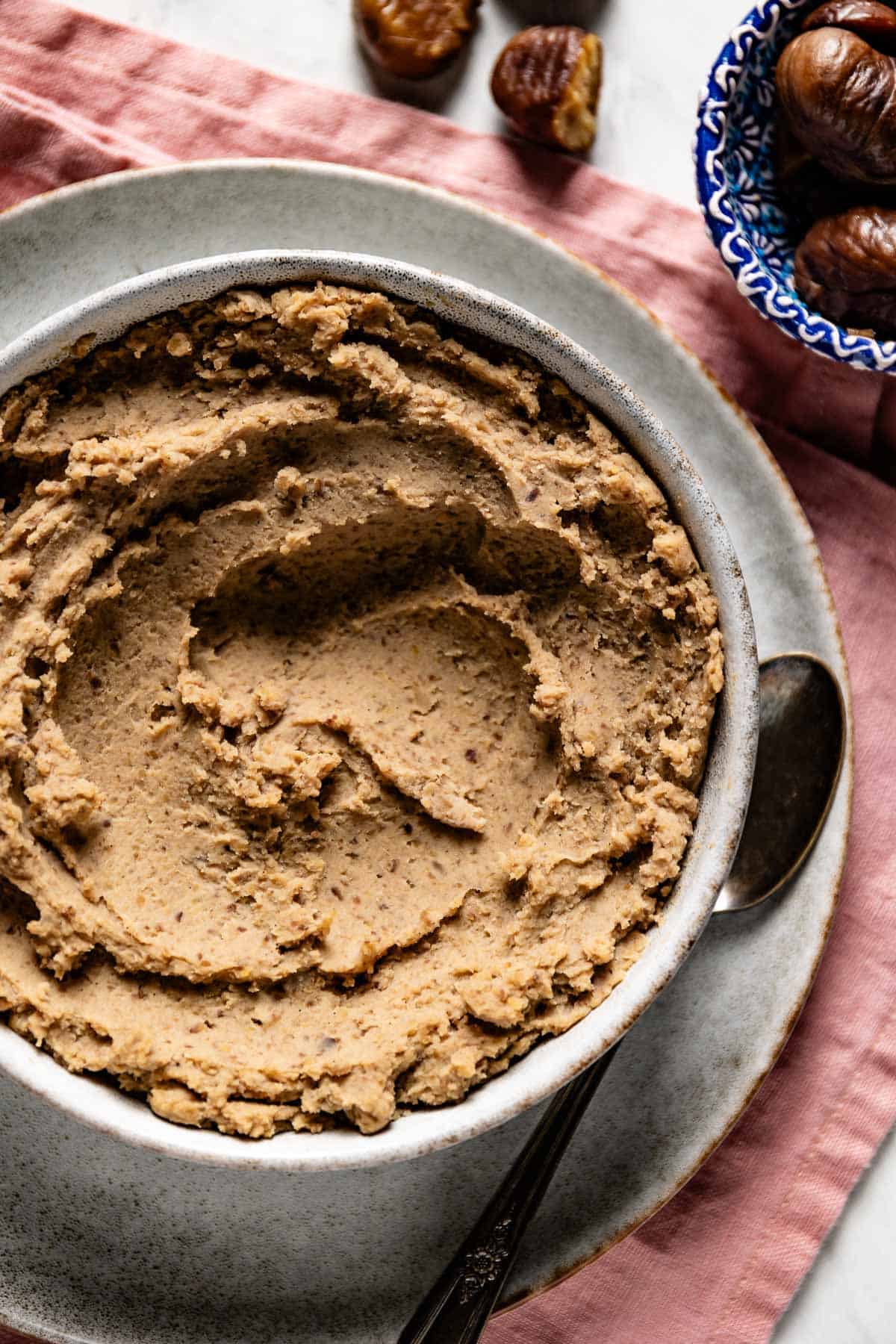
By contrast, a chestnut spread recipe, also known as crème de marrons, is much creamier, smoother, and sweeter, combining mashed candied chestnuts, simple syrup (or glucose syrup), and vanilla extract. This mixture’s sweeter notes, in turn, make it a go-to for sweeter recipes, such as desserts (such as French Mont Blanc), a spread for toast, and pastry fillings. In fact, one of the most popular brands of chestnut sauce is the sweet French chestnut spread called Creme de Marrons de L’Ardèche by Clément Faugier (affiliate link.)
Ingredients You’ll Need
You only need four simple ingredients to prepare this French chestnut paste recipe, making it one of the easiest, most cost-effective recipes you’ll cook up this season.

- Chestnuts: Selecting suitable chestnuts is critical to making this recipe smooth and nutty. If you buy cooked chestnuts from a store, make sure that they don’t have any added sugar and that the only ingredient is, in fact, “chestnuts.” My favorite brand is Blanchard & Blanchard’s organic whole chestnuts (affiliate link), which are already roasted and peeled. If you prefer to cook fresh chestnuts, I recommend cooking them following my recipe for boiling chestnuts. Alternatively, you can also cook them using my oven-roasted chestnuts, air fryer roasted chestnuts, or even fire-roasted chestnuts recipes, but please be aware that if you use these methods, you will end up with a chestnut puree with a slightly smokey flavor.
- Liquid: To make the classic version of this French chestnut recipe, I recommend using whole cow’s milk to simmer your chestnuts. This simple addition will give your puree a delicious creaminess and temper its earthiness. However, you can also use almond milk or water for a vegan chestnut puree recipe.
- Sweetener: Granulated sugar is the most common ingredient in sweetened chestnut puree, but natural sweeteners, like cane sugar, coconut sugar, or brown sugar, would also work. Furthermore, darker sugars will give your recipe a deeper, toffee-like taste. You can also add pitted dates to your cooking liquid for a healthier, more natural sweetness, as they’ll soften and infuse the mixture with their fruity, caramel undertones. If you’d prefer to make an unsweetened chestnut puree, omit the sugar in this recipe.
- Vanilla: Vanilla bean—or even vanilla bean paste (affiliate link) —makes a great addition to this chestnuts puree recipe, lending it sweet, delicate, and aromatic notes. However, if you’re looking for a less expensive, more everyday ingredient, you may use 1-2 teaspoons of vanilla extract (affiliate link) instead. Just be sure to add the vanilla extract to your puree only after you finish simmering, as adding it during cooking will evaporate its alcohol.
- Kosher Salt
Optional Add-Ins & Recipe Variations
- Chocolate or Cocoa powder: Adding cocoa powder or chocolate to your marron paste would work wonderfully to give it a complex richness and make it a delicious chestnut recipe you can use in your recipes. The chocolate chestnut puree also makes an incredibly delicious snack you can literally eat from the jar with a spoon. Simply add a few tablespoons of your favorite chocolate chips or cocoa powder while the chestnuts are still warm during the pureeing process.
- Alcohol: If you want to create authentic Hungarian chestnut puree at home, mix in a tablespoon of rum or cognac to your recipe. Then, you can quickly whip up a chestnut puree dessert by serving it with more sugar, another pour of rum, and a topping of whipped cream.
- Make it savory: If you want to make your chestnut recipes savory—just like you would for my hearty Chestnut Stuffing!—begin by substituting this recipe’s cooking liquid for vegetable stock or chicken broth. Then, instead of adding vanilla bean, steep your favorite fresh herbs, like thyme, sage, or rosemary, in the broth. Simmer the chestnuts as usual, then remove the sprigs from the mixture before pureeing.
How to Make Chestnut Puree?
This chestnut paste recipe comes together in a snap with only thirty minutes and four ingredients. Even beginner chefs can enjoy this simple chestnut dish’s earthy, mild nuttiness.
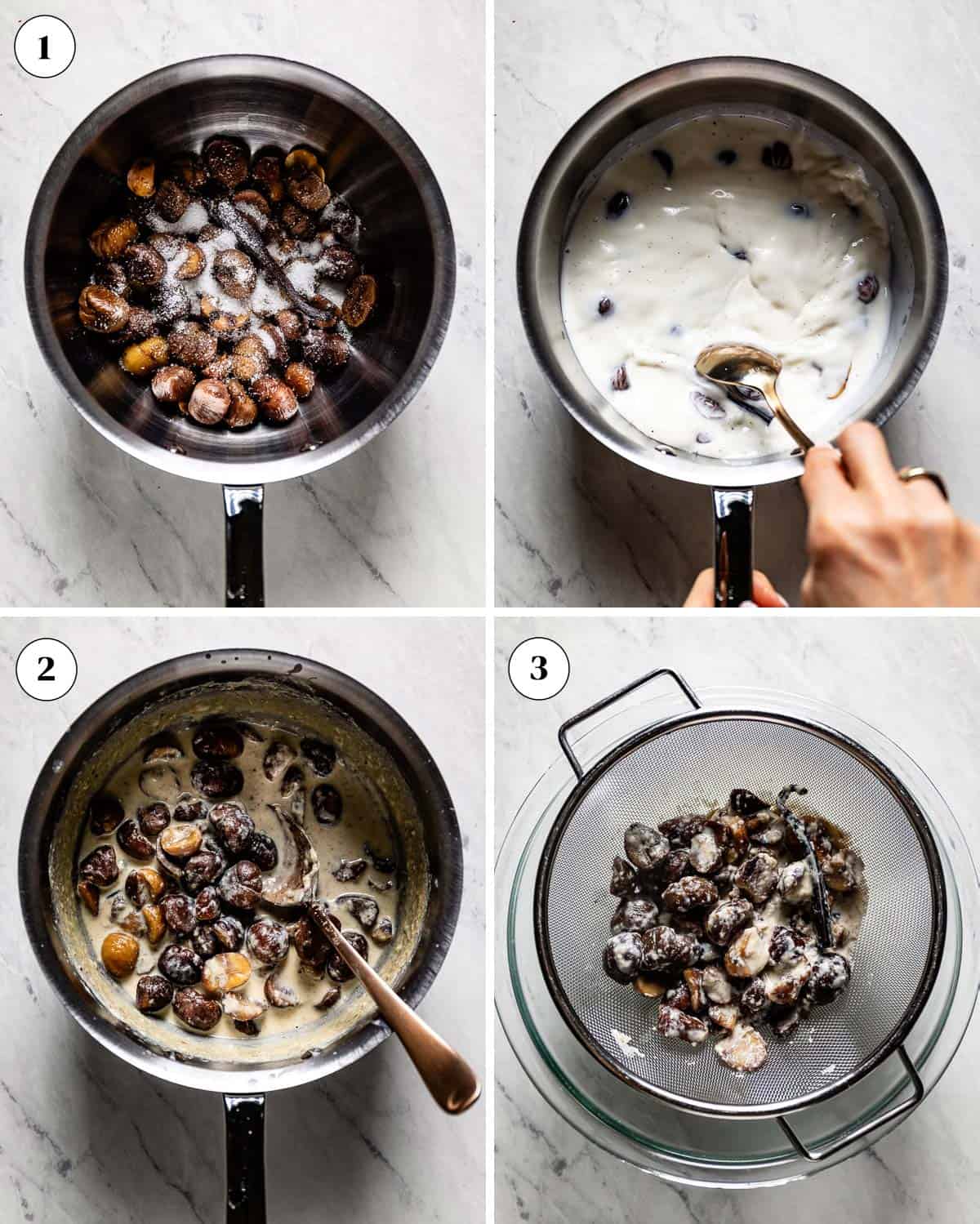
- Mix the ingredients: Add the chestnuts, milk, sugar, and vanilla bean to a saucepan and heat it over medium-high heat.
- Simmer the milk: Bring the mixture to a boil, then turn the heat down to medium. Stirring frequently, let the liquid simmer for 20-25 minutes or until the milk reduces to ¾ cup and chestnuts are softened.
- Strain the chestnuts: Place a mesh strainer over a bowl and pour the milk-chestnut mixture into it. Save the removed liquid in the bowl and remove the vanilla bean. You can also do this with the help of a slotted spoon.
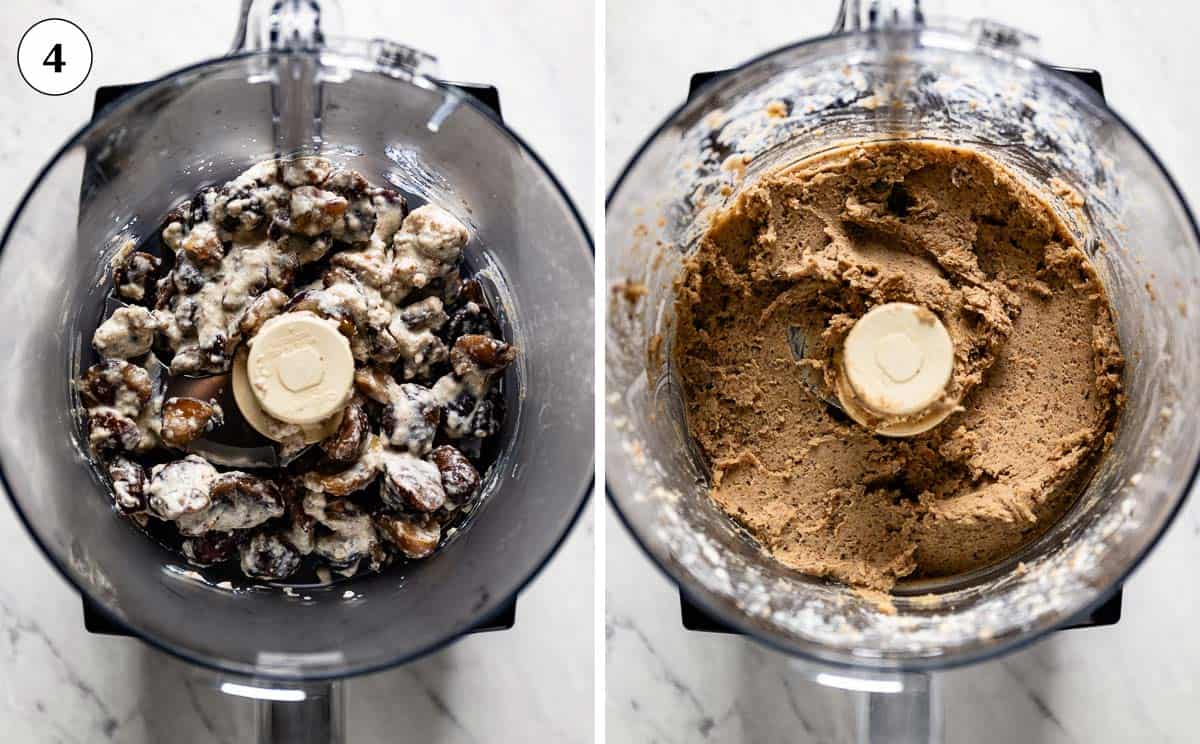
- Puree the chestnuts: Place the cooked chestnuts into the bowl of your food processor. Process them until pureed, stopping a few times to scrape the sides of the bowl.
- Adjust consistency: Depending on the recipe in which you plan to use your puree, you may adjust its consistency by adding the reserved cooking liquid as you blend your chestnuts.
How to Store and Freeze?
You won’t want to let a single teaspoon go to waste after making this easy chestnut puree. If you wish to store it for the next day or freeze it for months, these pro storage tips have you covered.
- Store: To store your chestnut puree, first bring it to room temperature and transfer it to an airtight container. You can then store it in the refrigerator for up to four days.
- Freeze: Freezing is an easy way to keep this recipe fresh for up to three months. Simply let your puree reach room temperature, place it in an airtight container, and freeze it. A day before you are ready to serve, thaw it in the fridge overnight. You may find that the paste may become watery or separate after thawing. If this occurs, give it a good stir to return it to its original texture.
How to Use Chestnut Puree?
One of the most common ways to enjoy chestnut puree is like the French do: spread it on toast or use it as a topping for yogurt. But why stop there? With your freshly made chestnut puree, you can create dishes that go far beyond the classics. Below is a variety of ideas for incorporating this rich, flavorful mashed chestnut recipe into a range of sweet, savory, and creamy recipes:
- Mont Blanc: This iconic French dessert begins by placing orange syrup and whipped cream on top of a small round of white cake, topped with a meringue. Once assembled, chefs often cover the whole dessert with a thin layer of whipped cream, followed by a thick coating of chestnut paste squeezed in the shape of vermicelli noodles. This vermicelli-style mont blanc strikes a decadent balance between nutty, sugary, and delicate flavors.
- Monte Bianco (Italian): Similar to the French Mont Blanc, this simple Italian version calls for a vermicelli-style serving of sweetened chestnut puree topped with whipped cream—a quick and sweet way to make a five-star dessert!
- Filling for pastries: Not only is this four-ingredient puree delicious by itself, but it also makes an incomparably delectable chestnut filling for cookie sandwiches, croissants, eclairs, and crepes.
- Flavoring for baked goods: Want to give your baked goods a smooth, nutty taste? This marron paste makes the perfect addition to all your favorite baked recipes, from cakes to muffins, cookie batters, and even bread puddings for a uniquely delicious flavor.
- Topping: Pack your breakfast with an extra dose of tasty nutrition by using your chestnut puree to top your morning Chia Seed Oatmeal, Overnight Steel Cut Oatmeal, or Almond Flour Pancakes. You can even start your day on the lighter side by layering your chestnut blend into a Yogurt Parfait.
- Blend into smoothies, custards, or ice cream: Try adding some sweetened chestnut puree to your favorite smoothie, custard, or ice cream recipes. Adding a dollop of this chestnut paste is an easy way to switch up your regular treats with new flavors.
- Stuffing and savory puddings: Who says chestnut puree can’t be savory? This simple ingredient makes an excellent addition to savory dishes like Chestnut Stuffing and Chestnut Puree Soup, and it even works as a flavor-packed soup thickener.
- Cheese platters: One of the easiest ways to serve this gourmet paste is alongside a plate of crackers and candied chestnuts, taking your Meat and Cheese Platter to the next level. Your chestnut lovers will thank you.
Expert Tips
You don’t have to be a French chef to make a chestnut puree worthy of a Parisian café. Here are a few pro tips to help you make a chestnut recipe that’s perfectly creamy, flavorful, and customizable.
- Good quality chestnuts: It’s no surprise that chestnuts are the star ingredient of this puree recipe. And not all chestnuts are created equal. My recommendation is to purchase Italian or American chestnuts instead of Chinese chestnuts, as they tend to have a richer flavor and it is easier to peel them. However, if all you can find is the Chinese variety, then my recommendation is to boil them to use in this recipe. Finally, it is probably obvious, but the chestnuts we are using here are totally different from water chestnuts, so be sure to look for the right chestnuts.
- Remove inner skin: If you’re boiling your chestnuts, be sure to remove their inner (fuzzy) skin before pureeing them. However, because this layer often clings to the walnuts harder than other layers, don’t worry if your chestnuts break during removal.
- Keep a close eye on it: While simmering your cooking liquid, keep an eye on the mixture, stirring occasionally while gently breaking the chestnuts with the back of a spoon. As the cooking progresses, this liquid will thicken, and you might begin to see some scorching (especially if you are using milk as your cooking liquid) near the end. Stirring will keep the mixture from burning and encourage a more consistent thickening.
- Adjust consistency: Depending on the recipe you plan to use, you may want this puree to have a thicker or thinner consistency. If you prefer a denser, more paste-like texture, strain all the cooking liquid from the chestnuts before pureeing. For a creamier, more delicate texture—more like the consistency of the chestnut spread—reserve the cooking liquid after straining the chestnuts and add it to the food processor until the puree reaches your desired consistency.
- Adjust the sweetness: Although it may seem like a lot, two tablespoons of sugar is very mild in this recipe—especially if you’re not using the cooking liquid in your paste. However, feel free to adjust the amount of sugar you use according to your tastebuds and selected recipe.
- Adding vanilla: Because of its mild yet rich notes, vanilla bean (or vanilla pod) is ideal for this mashed chestnut recipe, but vanilla bean paste (affiliate link) would also work. If you don’t have either, you can also use vanilla extract, but be sure to add it at the end of preparation, as the alcohol will evaporate during the simmering process.
- Blending: I use a food processor to give my chestnut puree an ideally creamy texture, occasionally stopping and scraping the sides. However, a blender or a potato masher would also work if you don’t have a food processor on hand.
FAQs
Chestnut puree is a simple, creamy mixture made with only four ingredients: chestnuts, a liquid (such as milk or water), sugar, and vanilla bean.
Absolutely! To freeze your puree, let it cool first. Then, place it in an airtight container with extra room at the top to accommodate any expansion. Once secured, you can freeze your chestnut paste for up to three months.
Not quite. Chestnut cream—also known as a chestnut spread or creme de marron—is a sweeter, creamier recipe than chestnut puree, and you can often find it in desserts and sweet recipes. Chestnut puree is thicker, milder, and more versatile, having uses in both sweet and savory recipes.
Suppose you prefer your chestnut puree on the sweeter side. In that case, you can enhance its flavor by adding more sugar, whether it’s traditional granulated sugar, cane sugar, or brown sugar. You can also sweeten your paste by adding dates to the cooking liquid and blending them into your chestnut mixture once soft.
If you try this Creme de Marron recipe or any other recipe on Foolproof Living, please take a minute to rate the recipe and leave a comment below. It is a great help to others who are thinking of making the recipe. And if you took some pictures, be sure to share them on Instagram using #foolproofeats so I can share them on my stories.
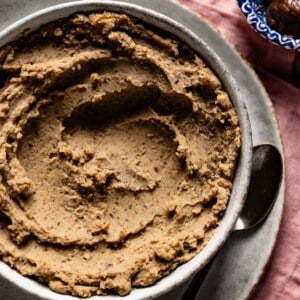
Chestnut Puree Recipe
Ingredients
- 2 cups cooked chestnuts*, or 16 oz cooked chestnuts drained – 350 g.
- 2 cups whole milk, or almond milk or water
- 2 tablespoons granulated sugar, or cane or coconut sugar
- ½ vanilla bean, or 1 teaspoon vanilla extract
- Pinch of kosher salt
Instructions
- Place chestnuts, milk, sugar, vanilla bean, and salt in a saucepan over medium-high heat.
- Bring to a boil, turn down the heat to medium heat, and let it simmer, stirring frequently, for 20-25 minutes or until the milk is reduced to ½ cup. After the first 15 minutes, it starts to thicken quite a bit, so keep a close eye on it.
- Place a mesh strainer over a bowl and carefully strain the chestnut and milk mixture, saving the liquid at the bottom. Remove the vanilla bean.
- Transfer the chestnuts to the bowl of a food processor and process until pureed, stopping and scraping down the sides a few times.
- Depending on the recipe you plan to use your chestnut puree, adjust its consistency by adding the reserved liquid as it is blending.
Notes
-
- Yields: This recipe yields about 1 ½ cups of pureed chestnuts. I listed it as 4 servings but you can adjust the serving size according to the recipe you are using it in. The nutritional values below are per serving based on 4 servings.
- Chestnuts: You can buy already cooked and peeled chestnuts from the store or cook your own chestnuts. If you purchase it from the grocery store, make sure the only ingredient listed on the packaging is chestnuts. If you decide to cook them yourself, I recommend following my boiled chestnuts recipe. Alternatively, you can cook chestnuts in the oven or roast them on an open fire, but please be aware that the end product might have a slightly smokier taste.
- Sweetener: While the most popular sweetener used in this recipe is granulated sugar, you can use cane sugar, brown sugar, or even coconut sugar as well. The darker sugar varieties provide a toffee-like taste. Alternatively, for a healthier option, you can substitute sugar with a few pitted dates.
- Vanilla: If you can’t get your hands on a vanilla bean, you can substitute it with vanilla extract. However, if you use vanilla extract, add it at the very end after the cooking is complete. Otherwise, all the alcohol (and flavors of vanilla) in the vanilla extract will evaporate during the cooking process.
- Vanilla bean: When using a vanilla bean, it is best the scrape the beans out of the vanilla pod using a sharp knife. You can still put the whole (scraped) vanilla pot in the cooking liquid for flavor.
- Storage: Bring the pureed chestnuts to room temperature and store it in an airtight container in the refrigerator for up to 4 days.
- Freeze: Freeze the leftover chestnut puree in an airtight container for up to 3 months. Thaw it in the fridge overnight.
Nutrition
Nutrition information is automatically calculated, so should only be used as an approximation.
